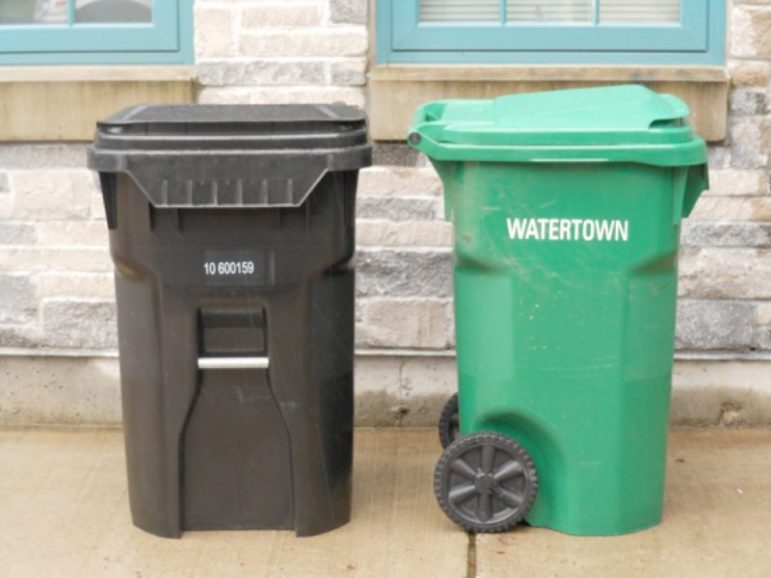
Photo by Watertown DPW Watertown trash and recycling toters.
What Should Watertown Residents Know About Where Our Trash Goes?
By David Chachava, Arafat Kabir, Caroline Marsh Zinser, and Milena Rauhut
I’m pretty sure that we have all asked this question once before, where does our trash in Watertown go? Well, we have finally solved that mystery.
Here’s a story about two chip bags. Bag number one gets thrown out. Then it’s whisked away by a garbage truck. Then it’s dumped into a gigantic pile of trash. That gigantic pile of trash is a landfill. 40% of Watertown’s trash goes to one of 6 landfills there are in Massachusetts. It takes bag one years to break down. Chip bag two also gets whisked away by a garbage truck. But bag two’s journey is much longer than bag one. It travels all the way to North Andover. Then it is dumped into another pile of trash and then later is burned by an incinerator (In-cin-a-rae-tor). 60% of our trash goes all the way to North Andover’s incinerator where it is then burned. Now you know where all the trash from Watertown goes.
Incinerators
Do you know what Incinerators are? They are where trash and waste get burned. 60% of our waste items are put inside of an incinerator and 40% goes to landfills. Incinerators produce gasses called “Dioxins” and “Furan” which can harm wildlife and ecosystems. The gasses are also bad for humans because the gas is blown into the oxygen and carbon into the air that living things need to survive. Plants need plenty of air and water to grow and make food for humans to eat. The good part is that incinerators make energy from the heat released from the burning. The burning converts water to steam, which is then sent to a turbine generator which produces electricity. Humans still are trying to figure out where to throw away trash. While incinerators DO produce energy, they also cause harmful gasses. This is why we need to have less trash!
Landfills
You may be wondering, where does the rest of our trash go? Well, the last 40% of our trash goes to landfills. A landfill is a big area of unused land where we store our trash. Because landfills are very large, it takes a lot of work and money to keep it running. Did you know that according to Mass.gov there are only six landfills left in Massachusetts? They will all fill up in about six years! Once they are full, they will close and then we won’t have anywhere to put our trash! If food scraps are thrown into landfills, it produces a gas called methane that can pollute the air. When it rains, the waste produces a chemical called leachate that can contaminate our drinking water. Now you know why we need to produce less trash.
What Can We Do To Help?
For all you out there who are wondering if there is a way to stop this catastrophe, you should know that there IS a solution. To make sure that the landfills are still up and running for a little more than six years, we need to do some things first. To make sure the landfills keep on running, we need to stop putting food scraps and other compostable items into landfills. We need to compost them instead, because the food scraps and rain water cause methane and leachate spread. Also, we need to stop putting recyclable objects into the trash. You can recycle cardboard by going to the recycling center. You can go there and recycle so many things that people just throw away. Instead of using containers that you only use once, start using reusable containers. Those are some of the solutions that will help the landfills go on for more than six or more years in Massachusetts! Everyone can help in this act to help save the planet!
Excellent article. Here’s a question about reusable containers. In Europe, you can bring your empty wine bottle to the wine store and they will refill it. They will also refill other containers. In Watertown and Belmont, you cannot bring your glass jar/jug and have them refill it with, say, yogurt from Sophia’s. It’s a health regulation. Any chance this can change?
Kudos to the Lowell teachers who created this lesson! As a retired teacher, I believe this message should be repeated each year as part of school curriculums. Fifth grade is an excellent grade for action!
Bravo! Wow! and thanks to Lowell School students for your reporting. Timely too. There is a recent study in Science finding that U.S. landfills emit 40% more methane than previously thought. Methane, created by rotting trash, particularly food waste traps 80 times as much heat in the atmosphere as carbon dioxide over 20 years. Thanks again for your reporting.
Lise Paul, on behalf of Watertown Faces Climate Change